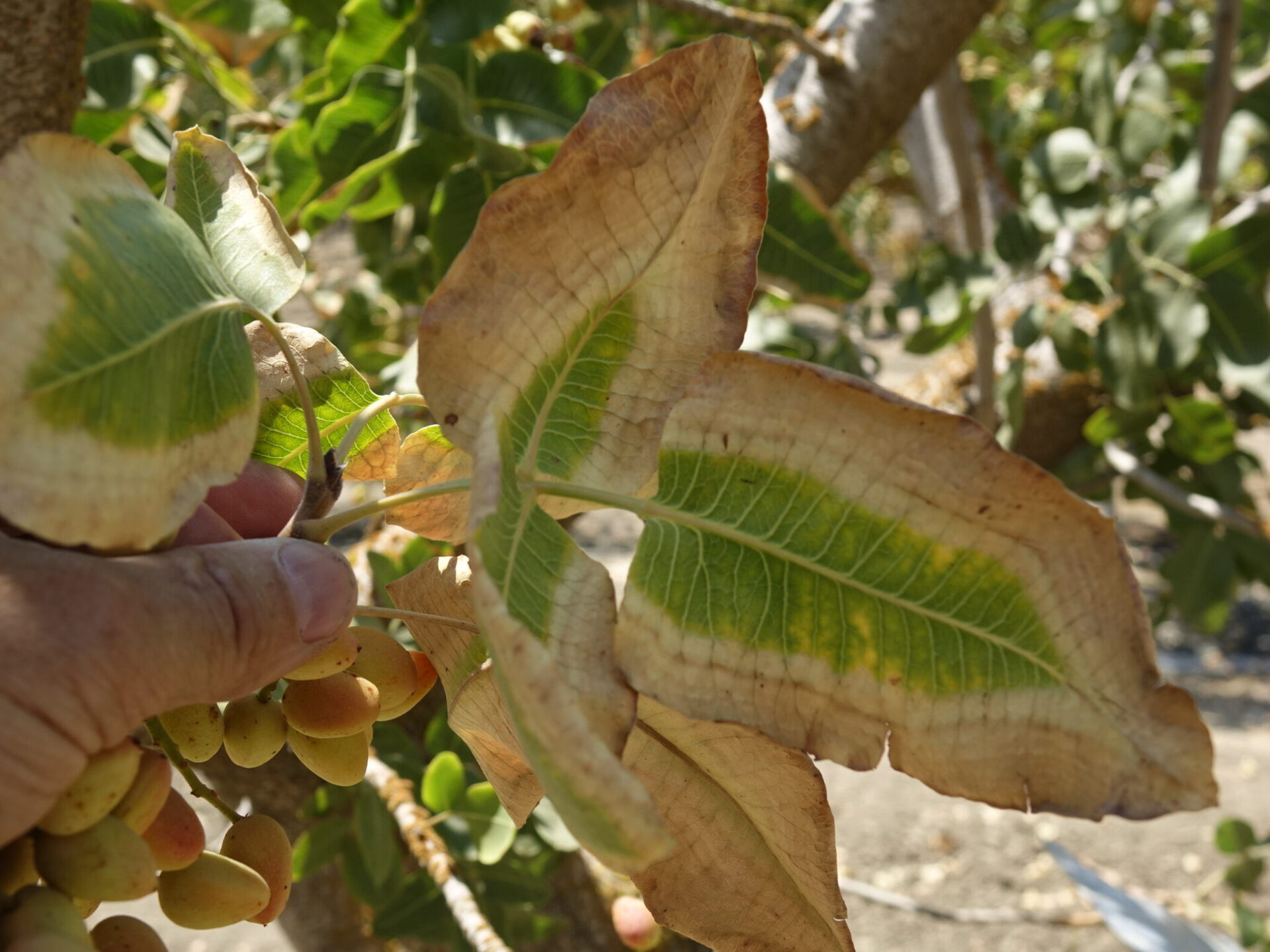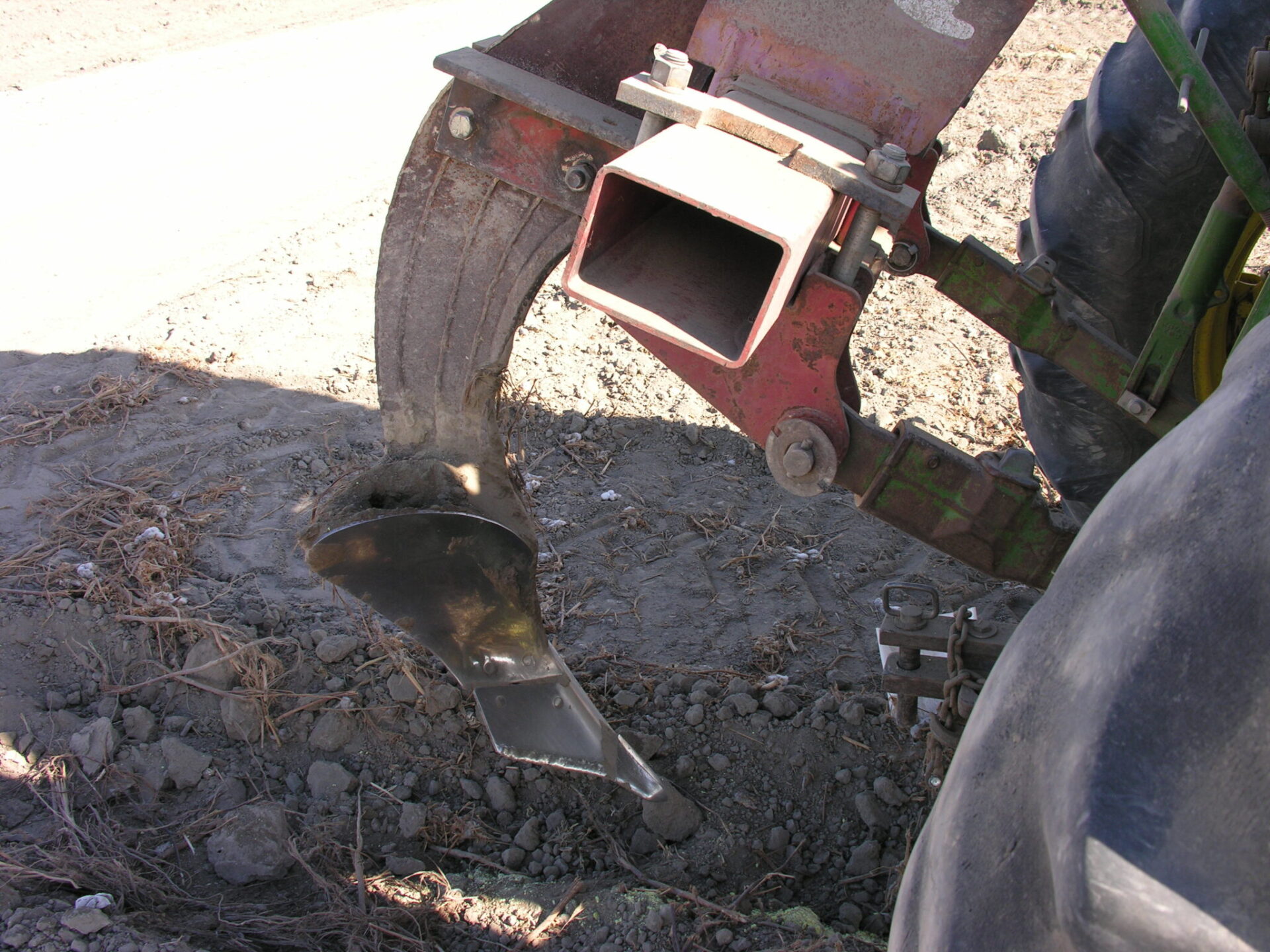
Two back-to-back years of dry winters with little snowpack has delivered an exceptional drought across California. Extreme heat in early June compounded the devastating impact dry conditions have had on agricultural crops across the Central Valley this growing season. In many areas, limited water supply has increased reliance on lower quality sources of irrigation water, which can initiate or intensify soil salinization problems. Salinization is the accumulation of salts in top layers of the soil, which intensifies when surface evaporation exceeds annual precipitation or when salts are inadequately leached due to problems with soil drainage.
Salinity and Soil Reclamation
Pistachio trees stand out among tree nut crops as tolerant of salty growing conditions, but they have their limits, and production may eventually be affected if steps are not taken to relieve stress that happens with salt accumulation. Irrigation water with electrical conductivity (EC) exceeding 4.5 to 7 dS/m is probably not sustainable for the long term, especially when salinity challenges are coupled with drainage issues.
When salinity levels are very high, trees are subjected to osmotic stress, meaning they are working harder to take up and transpire water. As salt concentrations increase around the roots, there is less solute differential between the root sap and the soil water, which reduces the ability of the root to pull in water by osmosis.
Recent UC research found salt affected soil resulted in lower yields but also lower water use. Salt-affected trees had the same ETa as non-saline sites earlier in the season through shell hardening (Stage II), but then the water use per unit of canopy cover decreased during kernel fill through the postharvest season. Despite the potentially lower water requirements during the growing season, salt-affected orchards will require additional water to leach salts from the rootzone during dormancy. Therefore, the overall amount of water needed to produce a crop in salt-affected areas needs to account for the necessary leaching requirements.
Leaching salts from the root zone can be effective in preventing salt build up in soils. Leaching is best accomplished during the winter when evapotranspiration rates are very low. The aim of dormant-season salinity management is to replenish soil moisture, improve water penetration and leach enough salt for efficient use of irrigation water during the growing season.
Soil and Water Amendments
Soil and water amendments improve water infiltration into the soil and are an important component of a reclamation program to reduce salts in the rootzone. Water and soil sampling and analyses should be conducted around early November to determine what amendments if any are needed. Amendments provide a source of Ca to replace the Na and remove it from the rootzone. This can be accomplished with either the direct application of soluble Ca (usually as gypsum) or by use of acidifying products that react with Ca bound by HCO3 or soil lime (CaCO3) to make the Ca ion soluble.
A combination of both amendments can be beneficial. The sulfate binds with Na to form a compound that is easily leached from the soil, while Ca takes its place on the surface of soil particles. A large quantity of Ca is generally needed to displace Na. Yet, because amendments add salts to the soil, too much at once can add to osmotic stress that limits water uptake by trees. Also, any excess applied Ca not displacing Na has potential to precipitate to form lime or even leach with the irrigation water depending on soil conditions.
The right amendment or combination of amendments largely depends on soil type, pH, the balance of Na with Ca and Mg, and whether there are appreciable amounts of HCO3 and CaCO3 in the water and soil. Calcium amendments are most useful to displace Na where soil pH is less than 7.5, native calcite or lime is less than 1%, and in areas with ultrapure low EC (<0.2) water. The most common Ca supplying product, gypsum, is valued for its moderately slow release of soluble calcium (24%) to continually improve infiltration and provide a source of plant nutrients.
Acidifying amendments are generally most useful in sodic soils with a high pH with soil lime levels greater than 1%. High levels of HCO3 can also be effectively neutralized by some acids. If soils have less than 1% lime, Ca must be added with the acid to create gypsum in the soil for Na to be leached. However, before these processes can take place, acid-forming amendments (e.g., sulfur, ammonium polysulfides and thiosulfates) require an initial biochemical oxidation of sulfides (S2) by bacteria named Thiobacillus to form the sulfuric acid that then breaks down the lime to form free Ca and gypsum.
This is important to note because soil temperature and moisture greatly influence microbial activity and the successful conversion of the acid amendment to gypsum. Moist soil with temperatures above 55 degrees F for a period of one to two weeks is needed for the reaction to take place. Optimal soil conditions are around 80 degrees F; therefore, a fall application of sulfur will likely provide Na leaching benefits the following growing season rather than during the dormant period when it is commonly applied. Sulfuric acid and other sulfate-based liquid acids like urea sulfate make gypsum in the presence of a lime source, independent of temperature and moisture conditions, and do not require microbial oxidation. In addition to the removal of Na, sulfuric acid assists in dissolution of HCO3 in highly sodic soil and irrigation water. Sulfurous acid, a safer alternative to sulfuric, is generated with a sulfur burner, which is then injected into irrigation water. Sulfurous acid may provide longer residual acidity that continues to neutralize HCO3 and form gypsum.
The use of organic matter, including composts, mulches and cover crops, are a final consideration in soil amendment goals. Organic matter enhances microbial activity, leading to soil aggregation and improved infiltration, and can enhance the effectiveness of other amendments. Kern County Emeritus Soil and Irrigation Advisor Blake Sanden found mixing 1 ton of fine-ground soil sulfur with 4 tons biosolids compost and side banding over the drip hose (a 3-inch-thick by 2-foot-wide band) with a low salt source of well water successfully improved water infiltration in Eastside orchards with severe soil sealing problems.
Composts and mulches can also be sources of salt, which can accumulate with salts from irrigation water; therefore, laboratory analysis of these materials is recommended before use. Ongoing research is investigating whether additional surfactants, polymers, biostimulants and nutrient amendments reduce soil salinity and improve tree growth and yield in pistachio and almond trials. Cover crops have been shown to improve water infiltration, protect the soil from surface crusting and, in some instances, significantly reduce soil Na levels. Current research is looking at the benefits and tradeoffs associated with their use in established pistachio blocks.

Leaching Salts from the Rootzone
Amendments alone will not reduce soil salinity and must be followed by leaching to be successful. Once the appropriate amendments have been applied to the soil, calculations are needed to determine the appropriate depth of water to reduce the salt load. The amount of water needed will depend on the texture of the soil, the EC level of the rootzone, the final salinity level goal and the EC of the reclamation water. Soil salinity can only be decreased to the concentration of salts in the water used for reclamation.
For saline-sodic and sodic soils, make dormant gypsum amendment applications in the fall prior to rain and leaching. Depending on the soil texture and salt load, six to ten inches of effective rainfall (penetrating past a two-inch depth) or freshwater winter irrigation is needed for efficient leaching. Leaching calculations and conversions can be found at ucanr.edu/sites/Kern22/files/275935.xlsx.
If leaching with fresh irrigation water, the first application should fill the soil profile to field capacity. Allow two to four days for drainage, then begin leaching applications. Irrigators should make sure to keep irrigation sets to less than 24 hours to avoid the risk of soil saturation and Phytopthora. A good strategy is to begin applying water in January (one inch per event), leaving the soil some ability to absorb any rainfall that occurs before flowering. If no additional rainfall occurs, continue applying one inch every few weeks with the goal of reaching the target six to ten inches before March. Soil and irrigation water should be sampled again to determine effectiveness of the leaching and provide a reference point for the salt levels at the beginning and end of the growing season.















